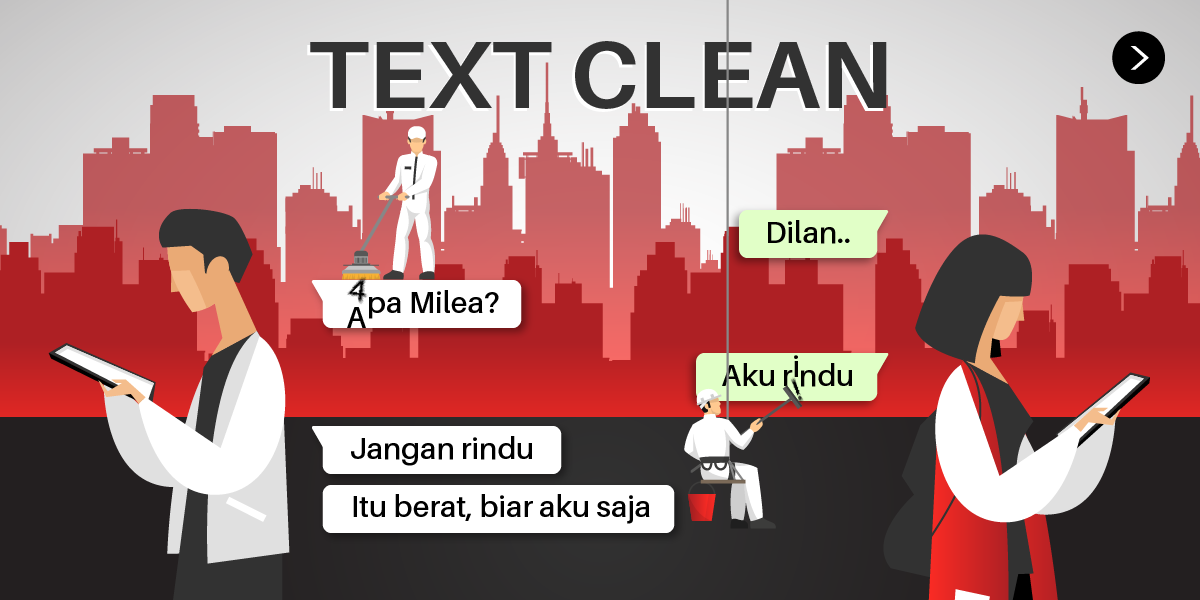
Social media has become a very popular spot for data mining these last years. But when we talk about social data, we actually also talk about unstructured data, and in order to derive any meaningful insight from it, we have to know how to work with it in its unstructured form (or in this case, unstructured text information).
Before the data we gather can be used for further analysis, the very first step to do is to clean the data. Most of the Tweet that we extract could be highly unstructured and noisy. Since it is an informal communication, we may find a lot of typos, usage of slang words, or presence of unwanted content like URLS, stopwords, emojis, etc..
Now, this process can even be more challenging when you work with non-English tweet text.
As one of the most populated countries in the world, it’s not really surprising to find that Indonesia is now the fifth-largest country in terms of Twitter Users. However, being language-specific, to process or analyze data in Indonesian topics could be pretty tricky since most text mining libraries only available for English (or some other major language) text processing.
In this article, we are going to discuss more about possible noise elements from Bahasa Indonesia-based text and how we could perform a simple cleaning process using textclean package in R.
We would also perform a mild analysis to acknowledge public opinion towards a certain topic by creating a word cloud from the most frequent used keywords of the Twitter data we gathered. For that, we would use other packages such as katadasaR and tokenizers.
Please be noted that this article only focus on cleaning text data in general, if you are interested to know more about Bahasa Indonesia text analysis algorithm or NLP, please refer to this link.
Packages Installation
There are actually many ways to perform text-cleaning process in R. We can find bunch of powerful packages that is actively developed by R text analysis community (tm or quanteda are ones amongst them). But in this article, we primarily make use of the textclean package for the following tutorial.
R’s textclean is a collection of tools to clean and normalize text. textclean differs from another packages in that it is designed to handle all of the common cleaning and normalization tasks with a single, consistent, pre-configured toolset (note that textclean uses many of these terrific packages as a backend). This means that the researcher spends less time on munging, leading to quicker analysis.*
Another essential package that we use is katadasaR. It provides a function to retrieve word stem for Bahasa Indonesia text using Nazief and Andriani’s algorithm.*. This package is currenly under development,so we have to install it by using devtools::install_github() functions.
Now, before we start, you might need to install and/or load the packages:
library(textclean)
library(katadasaR)
library(tokenizers)
library(wordcloud)
library(dplyr)Here, we have extracted some Tweets to analyze Indonesians opinions towards BPJS Kesehatan, Indonesian national health care insurance:

tweets <- read.csv("data_input/bpjs.csv")
tweets <- tweets$text %>%
as.character()
head(tweets)#> [1] "\"Agenda aksi yang dihapus, misalnya soal outsourcing, mencegah defisit BPJS, menghapus memastikan ketersediaan obat di fasilitas pelayanan kesehatan, baik di rumah sakit maupun di Puskesmas dan banyak lagi yang lain. #PrabowoGalauVisiMisi"
#> [2] "\"Agenda aksi yang dihapus, misalnya soal outsourcing, mencegah defisit BPJS, menghapus memastikan ketersediaan obat di fasilitas pelayanan kesehatan, baik di rumah sakit maupun di Puskesmas dan banyak lagi yang lain. #PrabowoGalauVisiMisi"
#> [3] "\"Kalo surat keterangan sehat bisa pake bpjs mba?\"\n\n\"Oh ngga mba, soalnya kan ini sehat ya. Jadi ga discover bpjs\"\n\nHmm, sakit bayar, sehat pun bayar ya. Kehidupan jaman sqarang .-."
#> [4] "@_dickyekas @siqoqon @wayoek @afathngantuk @elisa_jkt @willypps Bukan cuma itu maaf sya bilang bayar BPJS itu sangat murah. Saya kelas 1 bayar 80k, sedangkan saat saya operasi tumor payudara, endoskopi dan bebebrapa kali perawatan sakit lambung itu semua 0 rupiah. Bisa ngitung ga kalau sya bayar sendiri habis brapa? Hehe"
#> [5] "@Ahmaddaud8 @mynameisndy Sebenernya itu masalah di RS-nya.\n\nKalau dapat RS bagus, perlakuan untuk pasien BPJS, asuransi swasta, ataupun yang reguler itu sama kok.\n\nPernah gitu soalnya, ngalamin sendiri pas sakit ataupun nganterin keluarga."
#> [6] "@alterrrego_ Apa mungkin, karena udah era bpjs gini orang jadi lupa ya sama upaya promosi sama prevensi kesehatan? Jadi nganggepnya gapapa kalau sakit kan ada bpjs, jadi mereka ngerasa posyandu yang pada dasarnya emang kenceng di promosi dan prevensi jadi kaya dilupain gitu"Text Cleaning Process
As mentioned before, textclean provides a lot of powerful tools that makes our cleaning process a lot, lot easier. Take for example, the check_text function which scans text variables and give potential problems as the output.
But since we’re not working with English-based text, some of the tools in this package become less relevant to our process. If you’re working with English-based text and want to learn more about other features of textclean that is not mentioned in this article, or just curious on how you could maximize the use of this package, you should jump to this learnR page.
Text Subbing
The sub() function (short for substitute) in R searches for a pattern in text and replaces this pattern with replacement text. You use sub() to substitute text for text, and you use its cousin gsub() to substitute all occurrences of a pattern. (The g in gsub() stands for global.)
Another common type of problem that can be solved with text substitution is removing substrings. Removing substrings is the same as replacing the substring with empty text (that is, nothing at all).*
tweets[3]#> [1] "\"Kalo surat keterangan sehat bisa pake bpjs mba?\"\n\n\"Oh ngga mba, soalnya kan ini sehat ya. Jadi ga discover bpjs\"\n\nHmm, sakit bayar, sehat pun bayar ya. Kehidupan jaman sqarang .-."tweets <- gsub( "\n"," ",tweets)tweets[3]#> [1] "\"Kalo surat keterangan sehat bisa pake bpjs mba?\" \"Oh ngga mba, soalnya kan ini sehat ya. Jadi ga discover bpjs\" Hmm, sakit bayar, sehat pun bayar ya. Kehidupan jaman sqarang .-."Text Replacement
Replace HTML & URLs
To pre-process text with textclean is kinda cool since it provides several functions that allow us to replace substrings within text with other substrings that let us to analyze the data easier.
Let’s start by removing the HTML & URLs on our Twitter data:

# print original text data on index [199]
tweets[199]#> [1] "Yap, karena BPJS almarhum bapak dlu bisa bertahan cuci darah. Kalau gak ada udah jual ini itu. Sekarang, masih bayar BPJS, meski gak kepake krn ga sakit. Tp itu langkah yg bagus buat ngurangin rasio gini, ketimpangan. https://t.co/h2R6QrxQh0"tweets <- tweets %>%
replace_html() %>% # replace html with blank
replace_url() # replace URLs with blank# print replaced text data on index [199]
tweets[199]#> [1] "Yap, karena BPJS almarhum bapak dlu bisa bertahan cuci darah. Kalau gak ada udah jual ini itu. Sekarang, masih bayar BPJS, meski gak kepake krn ga sakit. Tp itu langkah yg bagus buat ngurangin rasio gini, ketimpangan. "That’s it! Pretty simple isn’t it? You don’t have to create even have to define specific regex to specify certain condition.
Replace Emoticons and Emojis
It’ll also be the same when you manage to on handle tweets with emoticons or emojis. But, note that in some cases, rather than strip the emojis from our text data, the function would rather change them to html format.
So, if you consider this as part of noises, you might also need to perform replace_html function after converting the emojis as well.

# print original tweet in index [198]
tweets[198]#> [1] "Yang pada ngejelekin BPJS pasti ga pernah ngerasain bayar ratusan juta buat rumah sakit dan harus ada saat itu juga.. Tawain aja П"# print original tweet with converted emoji in index [198]
replace_emoji(tweets[198])#> [1] "Yang pada ngejelekin BPJS pasti ga pernah ngerasain bayar ratusan juta buat rumah sakit dan harus ada saat itu juga.. Tawain aja <c3><90><c5><b8>"# print tweet with converted html in index [198]
replace_html(replace_emoji(tweets[198]))#> [1] "Yang pada ngejelekin BPJS pasti ga pernah ngerasain bayar ratusan juta buat rumah sakit dan harus ada saat itu juga.. Tawain aja "# perform the replacement task to whole text variable
tweets <- tweets %>%
replace_emoji(.) %>%
replace_html(.)Replace Slang Words
Twitter, like other social media data, comprises of a majority of slang word. To avoid biases in our analysis, words like these should be transformed into standard words.
The replace_internet_slang from textclean has its own library for English text slang words. But, since new terms and acronyms can go viral overnight, we might also need to adjust the lexicon. Well don’t worry, the replace_internet_slang tool allows us to add our own lexicon, and this also makes it possible for us to put other language’s lexicon, such as Bahasa Indonesia to the function.
# print original tweet at index [100]
tweets[100]#> [1] "BPJS itu sistem syariah. subsidi silang, Tolong menolong. yg sehat membantu yg sakit, membantu masyarakat lain yg butuh fasilitas kesehatan.. Yg sehat yaa doanya sehat terus."# import Indonesian lexicon
spell.lex <- read.csv("data_input/colloquial-indonesian-lexicon.csv")
# replace internet slang
tweets <- replace_internet_slang(tweets, slang = paste0("\\b",
spell.lex$slang, "\\b"),
replacement = spell.lex$formal, ignore.case = TRUE)# print tweet after replacement at index [100]
tweets[100]#> [1] "BPJS itu sistem syariah. subsidi silang, Tolong menolong. yang sehat membantu yang sakit, membantu masyarakat lain yang butuh fasilitas kesehatan.. yang sehat ya doanya sehat terus."Text Stripping
Often it is useful to remove all non relevant symbols and case from a text (letters, spaces, and apostrophes are retained). The strip function accomplishes this. The char.keep argument allows the user to retain characters.
tweets[16]#> [1] " Semua diwajibkan pakai BPJS... Giliran sakit dilempar sana sini oleh pihak rumah sakit.."tweets <- strip(tweets)tweets[16]#> [1] "semua diwajibkan pakai bpjs giliran sakit dilempar sana sini oleh pihak rumah sakit"——————————————————————————
*We found some Twitter users tend to copy and paste some news headline regarding BPJS without throwing any sentiments. So before we go on to the next step, what we need to do is to use distinct from dplyr package to remove duplicated tweets.
To see if the data has no duplicate text, we can investigate the data using unique() function.*
tweets <- tweets %>%
as.data.frame() %>%
distinct()
# number of tweet rows after duplicated text removed
nrow(tweets)#> [1] 108——————————————————————————
Stemming, Tokenizing, and Word Cloud creation
Bahasa Indonesia Text Stemming
Stemming refers to the process of reducing inflected (or sometimes derived) words to their word stem, base or root form-generally a written word form. For example, “writing”,“writer”, all reduce to the stem “write.” Or, for example in Bahasa Indonesia it will be “membenarkan”,“pembenaran”, which all has benar as the root word.
In order to reduce the vocabulary and focus more on the sense or sentiment of our Twitter data, it is also essential to remove those affixes. katadasaR provides a function to retrieve word stem (a.k.a. word stemming) for Bahasa Indonesia using Nazief and Andriani’s algorithm. It consists of set of features to remove prefixes, suffixes or both, but still unable for infixes removal.
# example for katadasaR usage
katadasaR("membenarkan")#> [1] "benar"Let’s apply this to our whole text data:
tweets <- as.character(tweets$.)
# before stemming
tweets[46]#> [1] "manfaatnya terasa banget samaku apalagi pas aku sakit parah tiap bulan pasti dilarikan ke rs jadi biaya rumah sakit ku tertolong karena bpjs walau ada beberapa prosedur yang harus dilewati"stemming <- function(x){
paste(lapply(x,katadasar),collapse = " ")}
tweets <- lapply(tokenize_words(tweets[]), stemming)
# after stemming
tweets[46]#> [[1]]
#> [1] "manfaat rasa banget sama apalagi pas aku sakit parah tiap bulan pasti larik ke rs jadi biaya rumah sakit ku tolong karena bpjs walau ada beberapa prosedur yang harus lewat"We can see from the output, the affixes are gone after using the stemming function based on katadasaR package.
Tokenize & Stopwords Removal
After that, we use tokenizer package to make the documents into discrete words.
library(tokenizers)
tweets <- tokenize_words(tweets)
head(tweets,3)#> [[1]]
#> [1] "agenda" "aksi" "yang" "hapus" "misal"
#> [6] "soal" "outsourcing" "cegah" "defisit" "bpjs"
#> [11] "hapus" "mastik" "sedia" "obat" "di"
#> [16] "fasilitas" "ayan" "sehat" "baik" "di"
#> [21] "rumah" "sakit" "maupun" "di" "puskesmas"
#> [26] "dan" "banyak" "lagi" "yang" "lain"
#>
#> [[2]]
#> [1] "kalo" "surat" "terang" "sehat" "bisa" "pakai"
#> [7] "bpjs" "mbak" "oh" "enggak" "mbak" "soal"
#> [13] "kan" "ini" "sehat" "ya" "jadi" "enggak"
#> [19] "discover" "bpjs" "hmm" "sakit" "bayar" "sehat"
#> [25] "pun" "bayar" "ya" "hidup" "jam" "sqarang"
#>
#> [[3]]
#> [1] "bukan" "cuma" "itu" "maaf" "saya"
#> [6] "bilang" "bayar" "bpjs" "itu" "sangat"
#> [11] "murah" "saya" "kelas" "bayar" "k"
#> [16] "sedang" "saat" "saya" "operasi" "tumor"
#> [21] "payudara" "endoskopi" "dan" "bebebrapa" "kali"
#> [26] "awat" "sakit" "lambung" "itu" "semua"
#> [31] "rupiah" "bisa" "ngitung" "enggak" "kalau"
#> [36] "saya" "bayar" "sendiri" "habis" "berapa"
#> [41] "hehe"The output of this process, we suceed to breaks the text into discrete words called token.
library(stopwords)
myStopwords <- readLines("data_input/stopword_list_id_2.txt")
tweets <- as.character(tweets)
tweets <- tokenize_words(tweets, stopwords = myStopwords)
head(tweets, 3)#> [[1]]
#> [1] "c" "agenda" "aksi" "hapus" "outsourcing"
#> [6] "cegah" "defisit" "bpjs" "hapus" "mastik"
#> [11] "sedia" "obat" "fasilitas" "ayan" "sehat"
#> [16] "rumah" "sakit" "puskesmas"
#>
#> [[2]]
#> [1] "c" "kalo" "surat" "terang" "sehat" "pakai"
#> [7] "bpjs" "mbak" "oh" "mbak" "sehat" "discover"
#> [13] "bpjs" "hmm" "sakit" "bayar" "sehat" "bayar"
#> [19] "hidup" "jam" "sqarang"
#>
#> [[3]]
#> [1] "c" "maaf" "bilang" "bayar" "bpjs"
#> [6] "murah" "kelas" "bayar" "k" "operasi"
#> [11] "tumor" "payudara" "endoskopi" "bebebrapa" "kali"
#> [16] "awat" "sakit" "lambung" "rupiah" "ngitung"
#> [21] "bayar" "habis" "hehe"Final Wordcloud
class(tweets)#> [1] "list"tweets <- as.character(tweets)
library(wordcloud)
wordcloud(tweets)



 More details
More details More details
More details
Share this post
Twitter
Facebook
LinkedIn